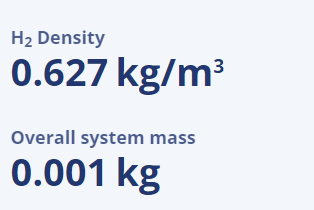Difference between revisions of "M. Said Jiddan Walta"
| Line 17: | Line 17: | ||
== Numerical Method - Case Study of Pressurized Hydrogen Storage == | == Numerical Method - Case Study of Pressurized Hydrogen Storage == | ||
| + | For the Numerical Method class, we were tasked with a project on the design and optimization of a Pressurized Hydrogen Storage, with the constraint parameters being the gas pressurized at 8 bars and the required storage volume being 1 liters. Hydrogen as a gas is useful for many industrial purposes as well as an energy source for certain vehicles and industrial appliances, and is often stored by the hundreds of liters in large tanks. | ||
| + | |||
| + | Hydrogen in its frequently encountered diatomic form of '''H2''' gas is the lightest gas in the universe and is generally unreactive, but is readily combustible in its gaseous form. As an ultra-light gas, hydrogen occupies a substantial volume under standard conditions of pressure, i.e. atmospheric pressure. In order to store and transport hydrogen efficiently, this volume must be significantly reduced. The general methods for improving hydrogen transport and storage efficiency is through high-pressure storage in the gaseous form, very low temperature storage in the liquid form, or hydride-based storage in the solid form, though the most common being the first two. Having the highest yield of hydrogen in a fixed container volume requires pressurization up to 700 bars or more, which requires large amounts of energy and strong container design. Liquid hydrogen is cryogenic in nature, and therefore needs to be stored in extremely low temperatures to keep it in its liquid state, or at least to keep a majority of it from evaporating. For the case that we are assigned, the required storage amount is small and the pressure is also constrained, therefore the focus is not the efficiency of hydrogen yield being stored but instead the cost and material effectiveness of the container. | ||
| + | |||
| + | For the purpose of this project, it is important to begin designing the product with understanding the substance that it is meant to store, in this case hydrogen pressurized at 8 bars. | ||
| + | |||
| + | [[File:H2Density_JW.png]] | ||
| + | |||
| + | In its gaseous form at 8 bars of pressure and local indoor temperature in Indonesia being around 30 degrees Celsius, hydrogen gas has a density of 0.627 kilograms per cubic meter, which results in 1 liter or 0.001 cubic meters of the gas weighing 0.627 grams or less than 0.001 kg. This means that storing the gas at these conditions will only require a container material and design that can withstand wall pressure of 8 bars, while ideally having lower density such that the total weight of the container far exceeds the weight of the gas being stored. | ||
== Numerical Method - Design of Pressurized Hydrogen Storage == | == Numerical Method - Design of Pressurized Hydrogen Storage == | ||
Revision as of 15:31, 29 May 2023
Contents
Introduction
Hello, my name is M. Said Jiddan Walta, commonly referred to as Jiddan. This page will be a platform for me to describe the results of my conscious learning and development during my short time in the Numerical Method class.
NPM: 2106718256
Major: Mechanical Engineering
E-mail: m.said11@ui.ac.id
Session Review
23 May 2023 Class
Numerical Method - Case Study of Pressurized Hydrogen Storage
For the Numerical Method class, we were tasked with a project on the design and optimization of a Pressurized Hydrogen Storage, with the constraint parameters being the gas pressurized at 8 bars and the required storage volume being 1 liters. Hydrogen as a gas is useful for many industrial purposes as well as an energy source for certain vehicles and industrial appliances, and is often stored by the hundreds of liters in large tanks.
Hydrogen in its frequently encountered diatomic form of H2 gas is the lightest gas in the universe and is generally unreactive, but is readily combustible in its gaseous form. As an ultra-light gas, hydrogen occupies a substantial volume under standard conditions of pressure, i.e. atmospheric pressure. In order to store and transport hydrogen efficiently, this volume must be significantly reduced. The general methods for improving hydrogen transport and storage efficiency is through high-pressure storage in the gaseous form, very low temperature storage in the liquid form, or hydride-based storage in the solid form, though the most common being the first two. Having the highest yield of hydrogen in a fixed container volume requires pressurization up to 700 bars or more, which requires large amounts of energy and strong container design. Liquid hydrogen is cryogenic in nature, and therefore needs to be stored in extremely low temperatures to keep it in its liquid state, or at least to keep a majority of it from evaporating. For the case that we are assigned, the required storage amount is small and the pressure is also constrained, therefore the focus is not the efficiency of hydrogen yield being stored but instead the cost and material effectiveness of the container.
For the purpose of this project, it is important to begin designing the product with understanding the substance that it is meant to store, in this case hydrogen pressurized at 8 bars.
In its gaseous form at 8 bars of pressure and local indoor temperature in Indonesia being around 30 degrees Celsius, hydrogen gas has a density of 0.627 kilograms per cubic meter, which results in 1 liter or 0.001 cubic meters of the gas weighing 0.627 grams or less than 0.001 kg. This means that storing the gas at these conditions will only require a container material and design that can withstand wall pressure of 8 bars, while ideally having lower density such that the total weight of the container far exceeds the weight of the gas being stored.

